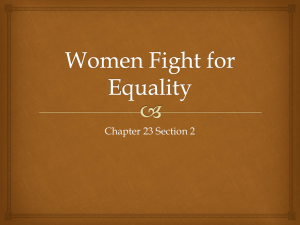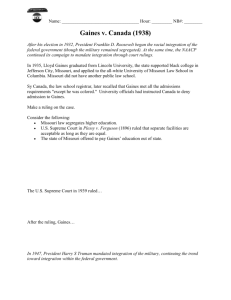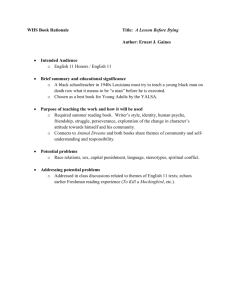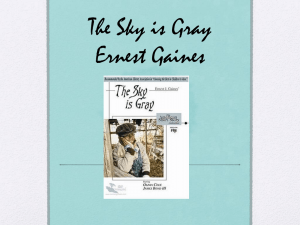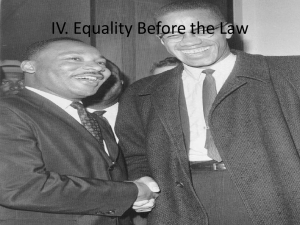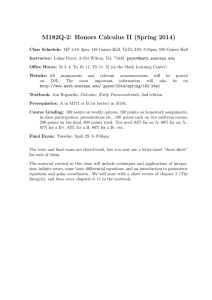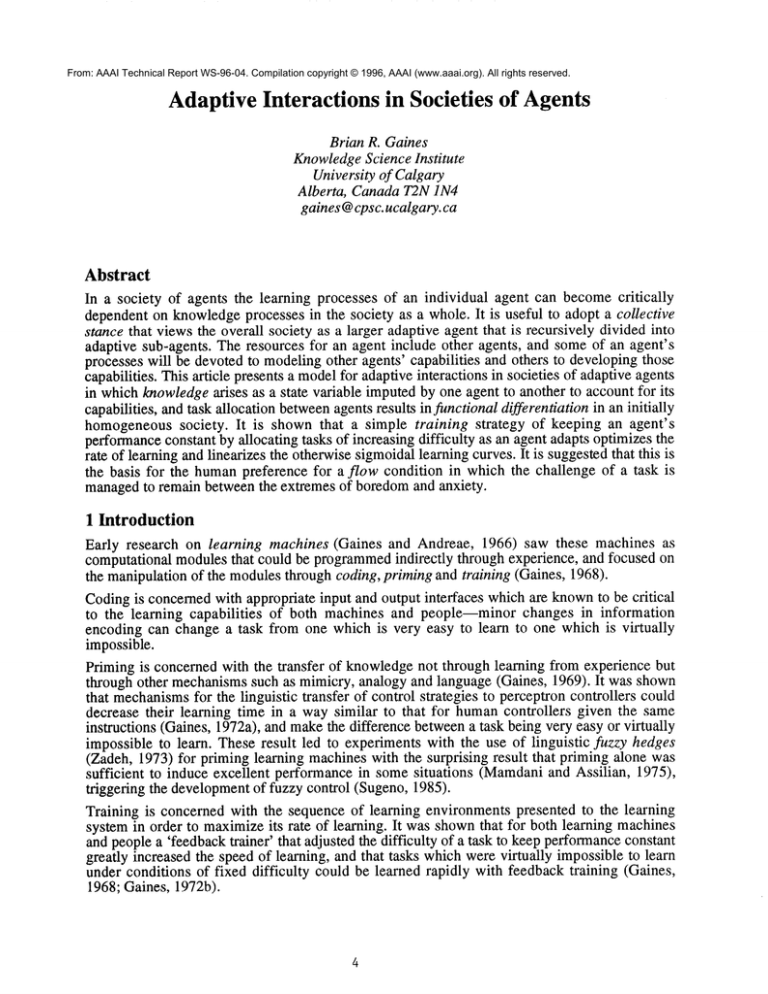
From: AAAI Technical Report WS-96-04. Compilation copyright © 1996, AAAI (www.aaai.org). All rights reserved.
Adaptive Interactions in Societies of Agents
Brian R. Gaines
KnowledgeScience Institute
University of Calgary
Alberta, CanadaT2N 1N4
gaines@cpsc. ucal gary. ca
Abstract
In a society of agents the learning processes of an individual agent can becomecritically
dependent on knowledgeprocesses in the society as a whole. It is useful to adopt a collective
stance that views the overall society as a larger adaptive agent that is recursively divided into
adaptive sub-agents. The resources for an agent include other agents, and someof an agent’s
processes will be devoted to modelingother agents’ capabilities and others to developing those
capabilities. This article presents a modelfor adaptive interactions in societies of adaptive agents
in whichknowledgearises as a state variable imputedby one agent to another to account for its
capabilities, and task allocation betweenagents results in functional differentiation in an initially
homogeneoussociety. It is shown that a simple training strategy of keeping an agent’s
performanceconstant by allocating tasks of increasing difficulty as an agent adapts optimizes the
rate of learning and linearizes the otherwisesigmoidallearning curves. It is suggestedthat this is
the basis for the humanpreference for a flow condition in which the challenge of a task is
managedto remain between the extremes of boredomand anxiety.
1 Introduction
Early research on learning machines (Gaines and Andreae, 1966) saw these machines
computational modulesthat could be programmedindirectly through experience, and focused on
the manipulation of the modulesthrough coding, priming and training (Gaines, 1968).
Codingis concernedwith appropriate input and output interfaces whichare knownto be critical
to the learning capabilities of both machines and people--minor changes in information
encoding can change a task from one which is very easy to learn to one which is virtually
impossible.
Priming is concerned with the transfer of knowledgenot through learning from experience but
through other mechanismssuch as mimicry, analogy and language (Gaines, 1969). It was shown
that mechanisms
for the linguistic transfer of control strategies to perceptron controllers could
decrease their learning time in a way similar to that for humancontrollers given the same
instructions (Gaines, 1972a), and makethe difference betweena task being very easy or virtually
impossible to learn. These result led to experiments with the use of linguistic fuzzy hedges
(Zadeh, 1973) for priming learning machineswith the surprising result that priming alone was
sufficient to induce excellent performance in some situations (Mamdaniand Assilian, 1975),
triggering the developmentof fuzzy control (Sugeno, 1985).
Training is concerned with the sequence of learning environments presented to the learning
system in order to maximizeits rate of learning. It was shownthat for both learning machines
and people a ’feedbacktrainer’ that adjusted the difficulty of a task to keep performanceconstant
greatly increased the speed of learning, and that tasks whichwere virtually impossible to learn
under conditions of fixed difficulty could be learned rapidly with feedback training (Gaines,
1968; Gaines, 1972b).
The effects of coding, priming and training are basic phenomenain any learning system. Now
that the aspirations of the 60s are beginningto be filled by the intelligent adaptive agents of the
90s, it is timely to revisit someof these phenomena.
In particular, research in distributed artificial
intelligence (Bondand Gasser, 1988), artificial life (Langton, 1995), and cultural evolution
(Boydand Richerson, 1985), raises issues of howa society of agents interacts to provide one
another with mutual training environments.
This article describes a collective stance modelof learning phenomena
in agent communitiesthat
accounts for the developmentof functional differentiation in uniform populations of adaptive
agents. In particular, it developsa quantitative modelof the wayin whichthe sigmoidal learning
curves of agents learning in static environmentscan be linearized through feedbacktraining, and
uses this model to account for a range of phenomenain communitiesof intelligent adaptive
agents.
2 Takinga Collective Stance
A useful perspective from whichto examinelearning phenomena
in agent societies is a collective
stance (Gaines, 1994) in which the society is viewed as a single adaptive agent recursively
partitioned in space and time into sub-systems that are similar to the whole. In humanterms,
these parts include societies, organizations, groups, individuals, roles, and neurological functions
(Gaines, 1987). Notions of expertise arise because the society adapts as a whole through the
adaption of its individual agents. The phenomenaof expertise correspond to those leading to
distribution of tasks and functional differentiation of the individual agents.
Themechanismfor functional differentiation is one of positive feedback from agents allocating
resources for action to other agents on the basis of those latter agents past performanceof similar
activities (Gaines, 1988). Distribution and differentiation follow if performanceis rewarded, and
low performers of tasks, being excluded by the feedback mechanismfrom opportunities for
performanceof those tasks, seek out alternative tasks wherethere is less competition.
The knowledge-level phenomenaof expertise, such as meaning and its representation in
language and overt knowledge, arise as byproducts of the communication, coordination and
modeling processes associated with the basic exchange-theoretic behavioral model. The
collective stance model can be used to account for existing analyses of humanaction and
knowledgein biology, psychology, sociology and philosophy (Gaines, 1994).
Simple simulation experiments of a competitive environment for two agents can illustrate the
formation of expertise through positive feedback (Gaines, 1988). For example,let the rules of
basic phenomenologicalsimulation be that: each problem requires certain knowledge; if the
agent does not have the knowledgenecessary it guesses with a probability of success, learning if
it succeeds; the society chooses the expert for a problem with equal probability initially,
gradually biasing the choice according to success or failure; there is no communicationof
knowledgebetweenexperts. Figure 1 graph A plots the probability that one agent will be always
preferred and shows that this rapidly approaches 1.0--a best ’expert’ is determined. Graph A
showsthe expected knowledgeof the better expert and graph B that of the rival--one goes to
100%rapidly and the other is asymptotic to about 36%--there is objective evidence of the
superior ability of the chosen expert. Whichof the two agents becomesthe ’best expert’ is, of
course, completely chance.
The simulation shownis not MonteCarlo but based on the calculation of the exact probability
distributions involved. It can easily be adjusted to take into account differences betweenthe
experts: that one starts with greater knowledge;that one learns faster; that one is favoredinitially
(the prima facie credibility or ’well-dressed consultant’ phenomenon).Similar simulations have
been madeof different positive feedback mechanisms;for example, if both experts are given the
sameproblembut the problemdifficulty is adjusted upwardsif either gets it right--the situation
of keeping up in the scientific ’rat race.’ Effects have been introduced of the loss of knowledge
through inadequate opportunities for its application, the growthof scientific knowledgeso that
there is always more to be acquired, and differential access to priming through cultural
knowledgetransfer processes such as education. All the simulations bear out the expected
qualitative result, that a range of different positive feedbackmechanisms
in an agent society are
adequate to account for differential expertise in a sample with initially equal knowledgeand
capabilities.
100
90
80
70
60
50
40
3O
20
10
o
;
30
;
60
;
90
;
12o
;
;
150 180
Problem
;
210
;
240
:
270
_"
300
A: Percentage
probability that problemwill
be givento only oneof the two’experts’
B: Expectedknowledgeof superior ’expert’
C: Expectedknowledge
of inferior ’expert’
Figure 1 Simulationof the effects of positive feedbackon the formationof expertise
There is evidence that these processes occur in humancommunities. Sociologists have noted
positive feedback processes in the dynamics of the scientific community(Hagstrom 1965).
Merton(1973) coined the term the "Mattheweffect" for those features of the reward system
research that were biased towards allocating greater credit for the samediscovery to those with
an already established reputation. In medicine, a key learning resource is access to medical
problems, and the ’owner’ of such a problem has a keen personal interest in only allowing
someoneof very good reputation to handle it. The system, including considerations of legal
liability, funnels problemsto those whoare regarded as experts. It is, however,precisely these
problems from which newknowledgeis generated. Similar considerations apply to the award of
scholarships, invitations to scientific congresses, and so on (Blume1974). Theyalso apply not
only to individuals but also to social units such as a companysubject to governmentprocurement
procedures that are heavily biased to contractors with ’prior experience’ and with whomthe
governmentagency has ’prior experience.’
3 Performance-BasedFeedback Linearizes the Learning Curve
The effect upon individual agents of the social feedback processes described in the previous
section is to regulate the learning experiences available to the agent in such a waythat agents
with historically better performanceget the tasks judgedto be moredifficult. In a world with a
wide range of tasks of varying difficulty and with agents having limited capacities and lives, the
overall effect is that each agents performanceis kept roughly constant as it is given tasks of
increasing difficulty commensuratewith its learning as indicated by its performanceon previous
tasks. The agent is learning to cope with tasks of increasing difficulty so that its skills are
increasing, but being constantly presented with tasks just beyondits capabilities so that its
performanceis not.
It is interesting to attempt to develop a qualitative modelof the learning phenomenainvolved
using as weak assumptions about the adaptive agent as possible so that the model is widely
6
applicable. Consider a universe of tasks and a universe of knowledge such that an agent can
performa task if it has some,not necessarily unique, collection of knowledge.Assume(it will be
argued later without loss of generality) that items of knowledgeform a set-theoretic structure,
and that the difficulty of a task can be estimated in terms of the cardinality of a set of knowledge
that allows an agent to performit.
Assumethat when an agent is given a task for which its knowledgeis inadequate that the
probability of it guessing each missing item of knowledgeis q and that if it guesses all the
missing items it performsthe task and learns the knowledge,but otherwise learns nothing.
Assumethat the training systemcan select a task at a given level of difficulty but does not know
either the knowledgerequired to performit or the state of the agent’s knowledge.
Assumethat the probability that the agent knowsa randomlyselected item of knowledgeis p,
and that the probability that it learns an unknown
item during a task necessitating it is q.
Thenthe probability that an agent will performa task of difficulty d is:
d
P(n)=~(dlpd-i(1-p)iqi=(p+(1-p)q)
O\tj
(1)
and the expectedrate of learning is:
L(n)= !(d)" di tp -i(1-p)iqi=d(1-p)qp+_l-pq
d-l( ( )
(2)
If one selects a task difficulty that optimizesthe rate of learning by maximizingL(n) with respect
to n then:
(3)
dopt = -11 ln(p + (1 p)q)
and the expectedperformanceto achieve this is:
Popt=l/e=.37
(4)
and the expected maximum
rate of learning is:
Lop’ = -(1 - p)q/(e(p (1- p)q)ln(p + (1 - p)q))
whichis such that as agent learns and p approaches1:
Lop
‘ = q / e(1 - q)
(5)
(6)
p---)l
Theimplication of equation (4) is highly significant becauseit implies that a training systemthat
adjusts the task difficulty to keep performanceconstant will achievea linear rate of learning that
is the fastest possible.
Onecan also deduce from equation (4) that the optimumperformanceinvolves the learning agent
being correct 37%of the time--i.e, an error rate of 63%.However,this result is misleading
unless one does a sensitivity analysis. Suchan analysis showsthat the learning rate drops to half
optimum whenthe error rate decreases to 20%or increases to 80%--i.e. that the optimum
learning performanceis relatively insensitive to the performanceset-point chosen. Thereason for
this is that there is a lower chance of learning moreat lower performances,and a greater chance
of learning less at higher performances.
Thus a feedback trainer that adjusts task difficulty to maintain performanceconstant can induce
optimumlearning in an adaptive agent, and achieve something close to this even if the
performancefluctuates over a 5 to 1 range.
Whathappens if an adaptive agent is given tasks to perform of constant difficulty. One would
expect the learning rate to be sub-optimalinitially becausethe task is to difficult, becomeoptimal
for a period as the performanceimprovesto a level wherethe difficulty is optimal, then decline
again as the performance improves to a level where the task is too easy. Figure 2 showsthis
results of integrating equation (2) for fixed n comparedwith the results of integrating (5), with
= 0.5 and full knowledgebeing 25 items. It can be seen that feedbacktraining achieves a speedup
in learning by a factor of 2 comparedwith the best fixed-difficulty training, that the learning
curves have the expected sigmoidal shape, and that training on tasks of high difficulty involves
very long learning periods.
Figure 2 Learning curves for adaptive agent undervarious training conditions
In practice there maybe complications that makethe effects showneven morepronounced. For
example, the universe of simple tasks maybe incomplete in that some knowledgeitems may
only be brought into use in relation to more complex tasks. Such dependencies between
knowledgeitems makefeedback training essential.
3.1 Corollary 1: Knowledgeas an ImputedState Variable
The generality of the results of Section 3 are dependent on the general applicability of the
learning modelused. It was noted that it wouldbe argued that the assumptionthat knowledgeis a
set of items can be madewithout loss of generality. Thebasis for this assertion is that the notion
of "knowledge"
is itself ill-defined and opento analysis and definition. Froma situated cognition
perspective, knowledgeis someindex of adaptivity:
"Thenewperspective,oftencalled situatedcognition,claimsthat all processesof behaving,including
speech,problem-solving,
andphysicalskills, are generatedon the spot, not bymechanical
applicationof
scripts or rules previously
storedin the brain.Knowledge
canbe represented,
but it cannotbe exhaustively
inventoriedbystatementsof belief or scripts for behaving.Knowledge
is a capacityto behaveadaptively
withinan environment;
it cannotbe reducedto representations
of behavioror the environment."
(Clancey,
1989)
Therepresentation of the skills of an agent by imputing to it "knowledge"as a state variable
indexing those skills is a social phenomenon
(Gaines, 1989). It is the wayin whichwe modelone
another for the purposesof task allocation and skill development.It is reasonable to hypothesize
that our modelsare effective in terms of task indexing and training, and to reverse the arguments
of Section 3 to propose that our folk modelsof knowledgeas a "substance" whichis "possessed"
by an agent are foundeduponthe results of that section--i.e, under this model, optimumtraining
leads to linear increase in knowledgewith time--the natural units of knowledgeare those of
improvementsper unit time in adaptive behavior.
3.2 Corollary 2: Flow as an Optimum Learning State
This article has emphasizedthe social provision of the optimal training conditions for learning.
However,what motivates the learner to seek out these conditions? Csikszentmihalyi’s (1990)
concept of flow as the phenomenonunderlying the psychology of optimal experience provides a
modelof the learner dynamics. Hoffmanand Novak(1995) summarizethe concept as:"Flow has been described as ’the process of optimal experience’ achieved when a
sufficiently motivated user perceives a balance between his or her skills and the
challenges of the interaction, together with focused attention."
The likeability of a task correlates with a flow state in whicha motivateduser undertakes a task
whoselevel of difficulty is at someparticular level that suits their individual needs. Too low a
level results in boredomand too high a level in anxiety, and the optimal level results in the
intense satisfaction with the activity that Csikszentmihalyitermsflow.
As the agent learns a flow state can be maintainedonly by increasing the task difficulty to keep
the performanceconstant. As shownin Section 3, this also maximizesthe rate of learning, and
this suggests that the flow process may have evolved phylogenetically as a mechanism
reinforcing an agent whichis maximizingits rate of learning. If the reinforcement center in the
brain is stimulated by conditions that optimize learning, then individuals will be attracted to
socially created learning environments.
4 Conclusions
In a society of agents the learning processes of an individual agent can becomecritically
dependent on knowledgeprocesses in the society as a whole. It is useful to adopt a collective
stance that views the overall society as a larger adaptive agent that is recursively divided into
adaptive sub-agents. The resources for an agent include other agents, and some of an agent’s
processes will be devoted to modelingother agents’ capabilities and others to developing those
capabilities.
This article has described a modelfor adaptive interactions in societies of adaptive agents in
which knowledgearises as a state variable imputed by one agent to another to account for its
capabilities, and task allocation betweenagents results in functional differentiation in an initially
homogeneoussociety.
It has been shownthat a simple training strategy of keeping an agent’s performanceconstant by
allocating tasks of increasing difficulty as an agent adapts optimizes the rate of learning and
linearizes the otherwise sigmoidal learning curves.
It has been suggested that this is the basis for the humanpreference for aflow condition in which
the challenge of a task is managedto remain betweenthe extremes of boredomand anxiety.
In conclusion, it is suggestedthat the approachtaken in this paper provides the foundationsfor a
bridge between cybernetic, phenomenologicalmodels of adaptive interactions in societies of
agents and knowledge-level modeling of the same phenomena. The simple model of knowledge
as a state variable imputed by one agent in modeling another is sufficient to account for the
performance-basedtraining phenomenadescribed. However,such training is powerful precisely
because it is independent of exact knowledgeof that state variable. If some knowledgeis
available then tasks maybe selected that are specific to the state of knowledgeof the trainee.
Other knowledge transfer phenomenasuch as mimicry and language may also be modeled and
controlled in similar terms. The higher-level knowledgeprocesses in societies of adaptive agent
maybe modeledas natural extensions of the basic phenomenadescribed.
Acknowledgments
Financial assistance for this work has been made available by the Natural Sciences and
Engineering Research Council of Canada.
References
Bond, A.H. and Gasser, L., Ed. (1988). Distributed Artificial Intelligence. San Mateo, Morgan
Kaufmann.
Boyd, R. and Richerson, P.J. (1985). Culture and the EvolutionaryProcess. Chicago, Illinois,
University of ChicagoPress.
Clancey, W.J. (1989). Viewingknowledgebases as qualitative models. IEEEExpert 4(2) 9-23.
CsikszenUnihalyi, M. (1990). Flow: The Psychology of Optimal Experience. NewYork,
Harper and Row.
Gaines, B.R. (1968). Training the humanadaptive controller. Proceedingsof the Institution of
Electrical Engineers 115(8) 1183-1189.
Gaines, B.R. (1969). Adaptively controlled instruction for a tracking skill. Programmed
Learning Research. Sciences de Comportement.pp.321-336. Paris, Dunod.
Gaines, B.R. (1972a). The learning of perceptual-motor skills by menand machinesand its
relationship to training. Instructional Science 1(3) 263-312.
Gaines, B.R. (1972b). Training, stability and control. Instructional Science 3(2) 151-176.
Gaines, B.R. (1987). Positive feedbackprocesses underlying functional differentiation. Caudhill,
M. and Butler, C., Ed. Proceedings of IEEEFirst International Conferenceon Neural
Networks.Vol.2. pp.387-394.
Gaines, B.R. (1988). Positive feedback processes underlying the formation of expertise. IEEE
Transactions on Systems, Man& Cybernetics SMC-18(6) 1016-1020.
Gaines, B.R. (1989). Social and cognitive processes in knowledgeacquisition. Knowledge
Acquisition 1(1) 251-280.
Gaines, B.R. (1994). The collective stance in modelingexpertise in individuals and
organizations. International Journal of Expert Systems7(1) 21-51.
Gaines, B.R. and Andreae,J.H. (1966). A learning machinein the context of the general control
problem. Proceedings of the 3rd Congressof the International Federation for Automatic
Control. London, Butterworths.
Hoffman, D.L. and Novak, T.P. (1995). Marketing in HypermediaComputer-Mediated
Environments: Conceptual Foundations. OwenGraduate School of Management,Vanderbilt
University, Nashville, TN.
http://www2000.ogsm.vanderbilt.edu/cmepaper.revision.july 11.1995/cmepaper.html.
Langton, C.E., Ed. (1995). Artificial Life: AnOverview. Cambridge, Massachusetts, MIT
Press.
Mamdani,E.H. and Assilian, S. (1975). Anexperimentin linguistic synthesis with a fuzzy logic
controller. International Journal Man-Machine
Studies 7(1) 1-13.
Sugeno, M. (1985). Industrial Applications of Fuzzy Control. Amsterdam,North-Holland.
Zadeh, L.A. (1973). Outline of a newapproach to the analysis of complexsystems and decision
processes. IEEE Transactions on Systems, Manand Cybernetics SMC-328-44.
lo

